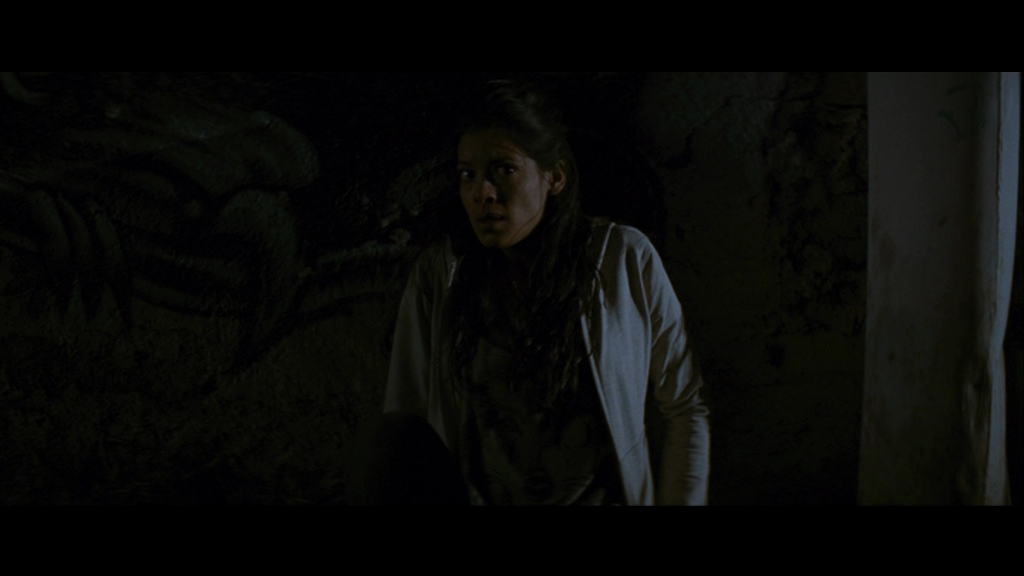I came to Gerardo Naranjo’s Miss Bala (2011) with some trepidation. There was much discussion about it at LASA 2012 in San Francisco, as a disappointing film for several reasons. There was also a sense that many were jaded that the “single story” about Mexico was and continues to be the ongoing violence amongst cartels, which I have written about here. I was largely trying to gloss over the comments so that I could watch the film on its own terms.
Set largely in Tijuana, the film is about a young woman, Laura Guerrero (Stephanie Sigman), who gets caught up with a cartel when she is accidentally witness to a bloody shooting in a club when she is trying to persuade her friend, Suzu (Laksmi Picazo), to come join her to go shopping. She is spotted by the gunmen before the shooting, but, curiously, they decide to spare her life.
 She then runs out to warn her friend of what is about to happen. The club is sprayed with shots from automatic weapons and, in the chaos Laura loses sight of Suzu. Unsure of what happened to her friend, Laura attempts to find out by watching the news, calling friends/family (it’s unclear), and talking to a traffic police officer. The police officer hands her over to the cartel (neatly establishing collusion between state and the cartel), and the leader of the gang, Lino Valdez (Noé Hernández), enamoured with Laura, promises answers in exchange for her cooperation on a variety of dangerous activities.
She then runs out to warn her friend of what is about to happen. The club is sprayed with shots from automatic weapons and, in the chaos Laura loses sight of Suzu. Unsure of what happened to her friend, Laura attempts to find out by watching the news, calling friends/family (it’s unclear), and talking to a traffic police officer. The police officer hands her over to the cartel (neatly establishing collusion between state and the cartel), and the leader of the gang, Lino Valdez (Noé Hernández), enamoured with Laura, promises answers in exchange for her cooperation on a variety of dangerous activities. 
Their first meeting takes place in the back of his truck in an underground garage where he interrogates her. She truthfully answers his questions. At this point he discovers that she is looking for her friend because they had entered a beauty contest, Miss Baja California. His promises to organise her participation in this event become another tool in his armor to convince her to collaborate.
She does attempt escape, goes shopping with money Lino has given her,  gets caught by the US DEA and they take a phone from her that Lino had given her then they free her. Lino subsequently catches up with her at her house where she shows some initiative to save her young brother, to whom she is shown to be devoted, and her father, who she treats as useless and naive.
gets caught by the US DEA and they take a phone from her that Lino had given her then they free her. Lino subsequently catches up with her at her house where she shows some initiative to save her young brother, to whom she is shown to be devoted, and her father, who she treats as useless and naive.
Once their safety is established, her active role moves to that of passive pawn in the cartel’s war. She undertakes various tasks that they ask of her, including crossing the border with a large sum of money in order to buy ammunition, driving a getaway car, and agreeing to sleep with an army general in order to make him vulnerable to attack. In a respite in these activities she competes for and wins the Miss Baja crown, thanks to her cartel connections.
The film can be highly praised for the different approach it takes to the representation of violence. As Manohla Dargis says in The New York Times, it highlights the “tragic banality” of the everyday violence that has become routine for many living in these Mexican cities under siege thanks to the violence of the cartels and the army. It shows the industry and process involved in the sale and distribution of drugs; the corruption of the state and its forces; the routine security measures the cartel need to have; and the warlike plotting and organization they undertake. It is episodic in structure, which takes away from any idea of quest or coherent single venture that might seem heroic, instead, the random nature of the events and Laura’s ignorance of their plotting makes it all the more pervasive and banal.
The violence is rarely shown directly, but often takes place just out of shot with the camera focusing on Laura’s terrified reaction.  However, it is this attempt to de-spectacularize the violence and turn the camera on Laura that makes it one of its considerable weaknesses. She becomes “a bleak but prescient metaphor for a nation held to ransom”. As metaphorical figure, she is often seen dressed in white, grey or pastels, thus underscoring her innocence. Her passivity and lack of agency further draws attention to her as someone unable to cope with the scale of the violence and, again, pure and innocent of its machinations. We are not to fault her for her involvement, but should commend her for her survival skills. She is concerned with the ordinary stuff of contemporary (post)capitalism: shopping and beauty, and wants to (understandably) escape the poverty into which she was born.
However, it is this attempt to de-spectacularize the violence and turn the camera on Laura that makes it one of its considerable weaknesses. She becomes “a bleak but prescient metaphor for a nation held to ransom”. As metaphorical figure, she is often seen dressed in white, grey or pastels, thus underscoring her innocence. Her passivity and lack of agency further draws attention to her as someone unable to cope with the scale of the violence and, again, pure and innocent of its machinations. We are not to fault her for her involvement, but should commend her for her survival skills. She is concerned with the ordinary stuff of contemporary (post)capitalism: shopping and beauty, and wants to (understandably) escape the poverty into which she was born.
Laura’s silence is also worthy of some comment. She rarely speaks. When she does it’s usually in response to others. This silence increases the sense that she is removing herself from being an active participant in the action. In a striking moment of muteness, at the interview on stage at the beauty contest, she is asked whether she would prefer fame or money she remains silent, wells up and leaves the stage.  This has several functions: her later win is evidently unjust since she cannot perform on stage as expected; it could be read as a rejection of this false choice, perhaps, fame and money should not be the only options; and, most importantly, it is a demonstration of her state of shock at the violence that she has recently experienced. This latter element further underscores her metaphorical role in the film.
This has several functions: her later win is evidently unjust since she cannot perform on stage as expected; it could be read as a rejection of this false choice, perhaps, fame and money should not be the only options; and, most importantly, it is a demonstration of her state of shock at the violence that she has recently experienced. This latter element further underscores her metaphorical role in the film.
The silence also recalls other nearly mute female characters in recent films, including Leonera (Lion’s Den) (Pablo Trapero, 2008), about a woman implicated in a violent murder she may or may not have committed, and Maria Full of Grace (Joshua Marston, 2004), a story of a Central American drug mule. In both, similar to that of Laura in Miss Bala, the women’s near mute performances attest to their passivity when faced with circumstances outside of the ordinary, and alludes to their innocence and naivete.
Laura as metaphor is a victim of social chaos. She lacks ownership over the events. This lack of agency is one which women have been burdened with repeatedly in film. Even, for example, the otherwise brilliant recent Django Unchained (Quentin Tarantino, 2012), has been criticised for creating a passive female role whose function is primarily to wait to be saved. Unlike in Django Unchained, however, Laura as metaphor for the Mexican people turns the film into a portrayal of victimhood and inaction. Denying the Mexican people agency may be reflective of a high degree of frustration at a corrupt political system that has resulted in much death, however, it also over-simplifies a complicated picture that requires a more nuanced telling. It is a pessimistic vision and one which is hampered by its weak central character. Are the filmmakers suggesting that the only response to such violence is passivity and inaction? How about political engagement and social action, for example?
At a fundamental level, the plot stretches the believable when you have a character, like Laura, who has grown up in a troubled border city in an impoverished neighbourhood (therefore not sheltered by high walls and armed guards), who is surprised and shocked at the events that unfold and makes such poor decisions over the course of the drama. To get a sense of the absurdity of her (in)actions, the viewer would be advised to read the Tijuana-set sections of Roberto Bolaño’s majesterial epic 2666, or read these stats of death rates in the city to get a sense of the horrific and everyday nature of a conflict that has resulted in more than 60,000 deaths in 6 years (2006-2012), that is not yet over. Laura, and her fellow inhabitants of Tijuana, may not be completely inured to death, but she would know the consequences of passively conforming to Lino’s instructions and would have learned strategies for survival. Her actions involve cowering, hiding and warning others. Her motivation to participate in the Miss Baja competition is not shown to be anything other than a wish to escape poverty. The filmmakers don’t make it convincing that she is keen to win at all costs. Laura’s childlike behaviour is unconvincing and adds to a long list of weak, passive women caught up in the terrors of violence.